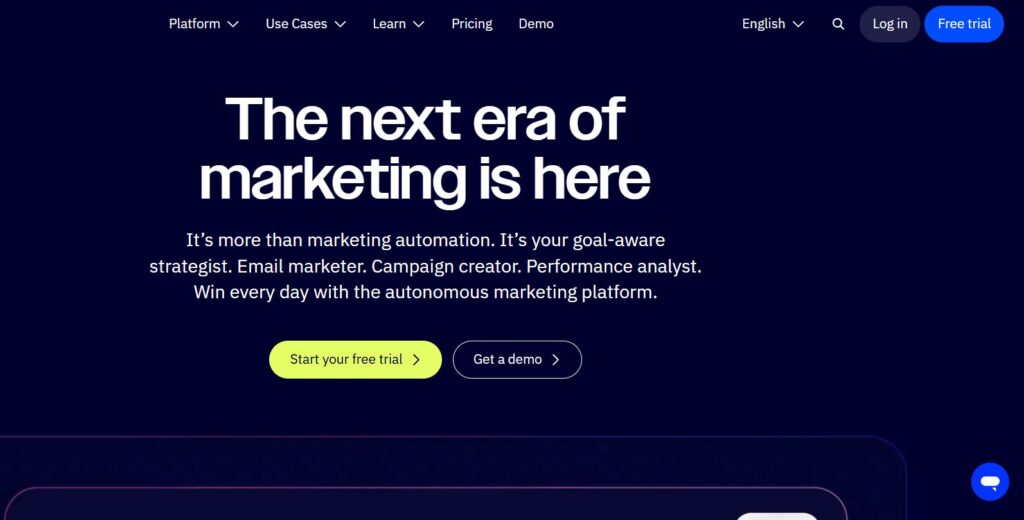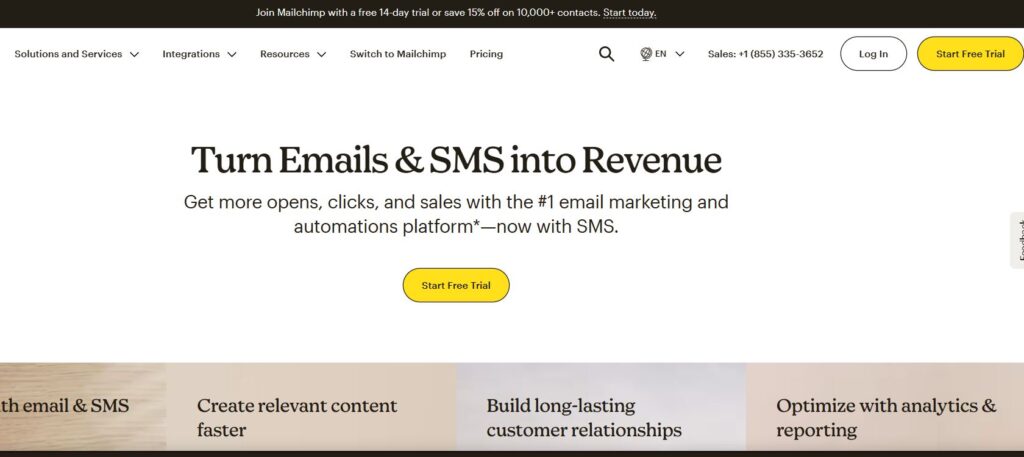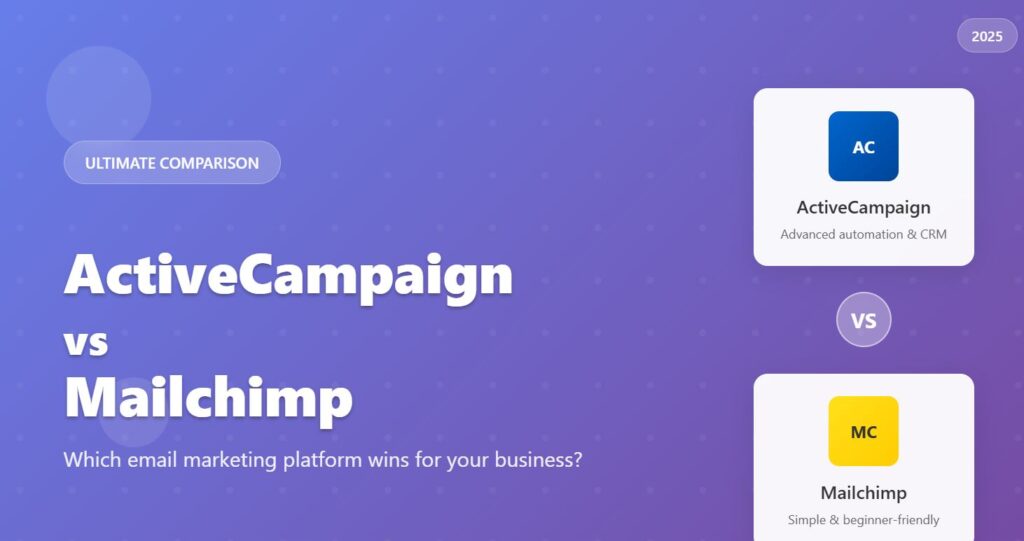I get this question a lot:
“Should I use ActiveCampaign or Mailchimp for email marketing?”
And here’s the thing:
Most comparison posts you’ll find online just list features from company websites. They don’t tell you what these platforms are actually like to use.
That’s exactly what this post fixes.
Today, I’m breaking down the real differences between ActiveCampaign and Mailchimp. The stuff that matters when you’re trying to grow your business.
Let’s dive in.
ActiveCampaign vs Mailchimp
Feature-by-feature comparison
| Feature | ActiveCampaign | Mailchimp | Winner |
|---|---|---|---|
| Ease of Use | ⭐⭐⭐ | ⭐⭐⭐⭐⭐ | Mailchimp |
| Marketing Automation | ⭐⭐⭐⭐⭐ | ⭐⭐ | ActiveCampaign |
| CRM Features | ⭐⭐⭐⭐⭐ | ⭐ | ActiveCampaign |
| Email Templates | ⭐⭐⭐ | ⭐⭐⭐⭐⭐ | Mailchimp |
| Behavioral Tracking | ⭐⭐⭐⭐⭐ | ⭐⭐ | ActiveCampaign |
| Segmentation | ⭐⭐⭐⭐⭐ | ⭐⭐⭐ | ActiveCampaign |
| Lead Scoring | ⭐⭐⭐⭐⭐ | ⭐ | ActiveCampaign |
| A/B Testing | ⭐⭐⭐⭐ | ⭐⭐⭐⭐ | Tie |
| Free Plan | ✗ | ✓ | Mailchimp |
| E-commerce Integration | ⭐⭐⭐⭐⭐ | ⭐⭐⭐ | ActiveCampaign |
| Customer Support | ⭐⭐⭐⭐ | ⭐⭐⭐ | ActiveCampaign |
| Deliverability | ⭐⭐⭐⭐ | ⭐⭐⭐⭐ | Tie |
Final Score
Winner: ActiveCampaign for advanced features, Mailchimp for simplicity
The Bottom Line (For People in a Hurry)
After using both platforms extensively:
- ActiveCampaign wins for advanced marketing automation and CRM features
- Mailchimp dominates for simplicity and getting started quickly
- Most serious marketers eventually outgrow Mailchimp’s capabilities
But that’s just scratching the surface.
Here’s what you really need to know…
The Automation Showdown (This is Where It Gets Interesting)
Let’s talk about the elephant in the room:
Marketing automation.
Because here’s what I’ve learned after years of email marketing:
Basic email blasts don’t cut it anymore. Your audience expects personalized, relevant messages based on their behavior.
ActiveCampaign: The Automation Powerhouse

ActiveCampaign’s automation builder is genuinely impressive.
You can create complex workflows that would make a marketing agency jealous:
Behavioral Triggers
- Send emails based on website pages visited
- Trigger sequences when someone downloads a lead magnet
- Automatically tag contacts based on their actions
Advanced Logic
- Create “if/then” branches in your automation
- Set up goal-based campaigns that stop when someone converts
- Build multi-step nurture sequences with smart delays
The Real Kicker: Site tracking that lets you see exactly what pages your subscribers visit. Game-changer for personalization.
Mailchimp: Solid But Limited
Mailchimp’s automation gets the job done for basic needs:
- Welcome series for new subscribers
- Abandoned cart emails for e-commerce
- Simple date-based campaigns (birthdays, anniversaries)
But here’s where it falls short:
The automation builder feels clunky compared to ActiveCampaign. And you’re missing advanced features like behavioral triggers and complex conditional logic.
Winner: ActiveCampaign (by a landslide)
User Experience: The Daily Reality Check
This might be the most important section.
Because it doesn’t matter how powerful a platform is if you can’t figure out how to use it.
Mailchimp: The Friendly Giant

Mailchimp nails the user experience for beginners:
- Clean, intuitive interface
- Drag-and-drop email builder that just works
- Helpful tooltips and guidance throughout
- You can create and send your first campaign in under 10 minutes
The downside? As you try to do more advanced stuff, the interface starts feeling limiting.
ActiveCampaign: Power with a Learning Curve
ActiveCampaign is more complex, no sugar-coating it.
The interface packs in tons of features, which can feel overwhelming at first. But once you learn your way around, you realize how much more you can accomplish.
Pro tip: Plan to spend a few hours learning the platform. The investment pays off.
Winner: Mailchimp for beginners, ActiveCampaign for power users
CRM Integration: Where ActiveCampaign Shines
Here’s something most people don’t realize:
ActiveCampaign isn’t just an email tool. It’s a full CRM system.
What This Means in Practice
Deal Pipeline Management
- Track leads through your sales process
- Set up automated follow-ups based on deal stage
- Get notifications when hot prospects take action
Contact Scoring
- Automatically score leads based on their behavior
- Focus your sales team on the hottest prospects
- Trigger different email sequences based on lead score
Sales Automation
- Send personalized emails from your sales team’s accounts
- Set up task reminders and follow-up sequences
- Track which emails your prospects open and click
Mailchimp’s CRM Story
Mailchimp has basic contact management, but it’s not a real CRM.
You can see purchase history and basic engagement data, but that’s about it. For serious sales pipeline management, you’ll need to integrate with external tools.
Winner: ActiveCampaign (no contest)
The Email Builder Battle
Both platforms let you create good-looking emails, but they take different approaches.
Mailchimp’s Email Builder
The Good:
- Drag-and-drop simplicity
- Tons of pre-designed templates
- Mobile optimization is automatic
- Content blocks make layouts easy
The Not-So-Good:
- Limited customization options
- Templates can look “Mailchimp-y”
- Advanced design features require HTML knowledge
ActiveCampaign’s Email Builder
The Good:
- More design flexibility
- Better personalization options (dynamic content blocks)
- Advanced conditional content features
- Clean, professional templates
The Not-So-Good:
- Steeper learning curve
- Fewer pre-built templates than Mailchimp
Winner: Tie (depends on your priorities)
Integration Ecosystem: The Hidden Factor
Your email platform doesn’t exist in a vacuum. It needs to play nice with your other tools.
ActiveCampaign Integrations
870+ integrations including:
- Deep Shopify and WooCommerce integration
- Seamless CRM connections (Salesforce, HubSpot)
- Advanced WordPress plugins
- Zapier for custom connections
The integrations tend to be more robust, often including advanced features like behavioral triggers.
Mailchimp Integrations
600+ integrations covering:
- E-commerce platforms (though less advanced than ActiveCampaign)
- Social media tools
- Popular business apps
- Strong Facebook and Instagram advertising integration
Winner: ActiveCampaign for depth, Mailchimp for breadth
Deliverability: The Make-or-Break Factor
This is crucial: what’s the point of great features if your emails don’t reach inboxes?
Both platforms have solid reputations for deliverability. They both:
- Follow email best practices
- Provide authentication tools (SPF, DKIM)
- Monitor sender reputation
- Offer delivery analytics
Neither platform has a clear advantage here, which is good news for everyone.
Winner: Tie
Who Should Choose What? (The Real Talk)
After diving deep into both platforms, here’s my honest recommendation:
Choose ActiveCampaign If:
You’re serious about marketing automation. If you want to create sophisticated, behavior-based email sequences that adapt to your subscribers’ actions.
You need CRM functionality. Especially if you’re a service business or have a longer sales cycle.
You’re planning to scale. ActiveCampaign grows with you. You won’t outgrow it anytime soon.
You have time to learn. The platform rewards users who invest time in mastering its features.
Choose Mailchimp If:
You want to get started quickly. If you need to send emails today and don’t want to spend hours learning a platform.
You’re just getting started with email marketing. The learning curve is gentle, and you can grow into more advanced features.
Simplicity is your priority. Sometimes you just want a tool that works without complexity.
You’re primarily focused on newsletters and basic campaigns. Mailchimp handles these beautifully.
The Verdict
If I had to pick one platform for most growing businesses?
Here’s why:
The automation capabilities alone justify the platform. In today’s competitive landscape, basic email blasts don’t cut it. Your audience expects personalized, relevant communication.
ActiveCampaign delivers that. Mailchimp… doesn’t, really.
But (and this is important):
If you’re brand new to email marketing, starting with Mailchimp makes sense. Get comfortable with the basics, then graduate to ActiveCampaign when you’re ready for more power.
Final Thoughts: What I Wish Someone Had Told Me
Here’s something most reviews won’t tell you:
Your email platform choice isn’t permanent.
I know plenty of successful marketers who started with Mailchimp, learned the ropes, then moved to ActiveCampaign as their needs evolved.
Both platforms make it relatively easy to export your data and migrate elsewhere.
So don’t stress too much about making the “perfect” choice right now.
Pick the platform that fits your current needs and skill level. You can always level up later.
The important thing is to start building your email list and connecting with your audience.
That’s what really moves the needle for your business.
Frequently Asked Questions
Can I switch from Mailchimp to ActiveCampaign later?
Absolutely. Both platforms offer migration tools, and there are services that specialize in platform migrations. Your contacts and basic campaign data transfer easily.
Which platform is better for e-commerce?
ActiveCampaign edges out Mailchimp here, primarily because of its advanced automation capabilities. You can create much more sophisticated abandoned cart sequences and customer lifecycle campaigns.
Do I need technical skills to use these platforms?
Mailchimp requires zero technical knowledge. ActiveCampaign benefits from some technical understanding, but it’s not required. Both platforms offer extensive help documentation.
Which platform has better customer support?
Both offer solid support, but ActiveCampaign’s support team tends to be more technically knowledgeable about advanced features. Mailchimp has more self-service resources.
The bottom line? Both are solid choices. Your specific needs should drive the decision, not feature checklists or marketing promises.
